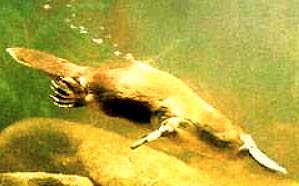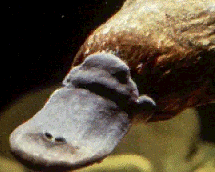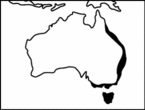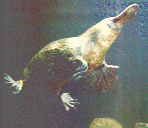Platypus, Duckbill
Platypus, Duckbill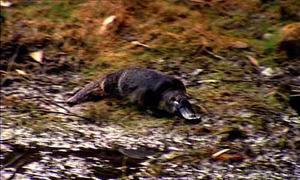 Ornithorhynchus anatinus In the past, platypuses were killed for their pelts but nowadays they are |
The platypus is a small, semiaquatic, oviparous mammal that lives in freshwater basinsalong Eastern Australia and Tasmania. It has a squat shape and broad, flattened
snout. It is famous for its insatiable appetite: each day this small animal eats nearly its own weight in crustaceans, mollusks, fish, frogs and earthworms.
It hunts for food in underwater mud. Because it is always very hungry, it is difficult to be hold in captivity.
Mature males have a pair of venomous spurs on the inside of their hind legs. They use them in the sexual combat. |
|
Their venom causes intense pain and local tissue damage in humans. The venom is composed of various enzymes that have a paralytic effect on the affected body area.
Swelling develops and the victims may be unable to move their limbs for days. In experimental animals, death has occurred because of respiratory failure.There is no specific treatment for a platypus sting. Analgesia is usually required and tetanus prophylaxis should be performed if the victim is not immunized.
Ornithorhyncus anatinus
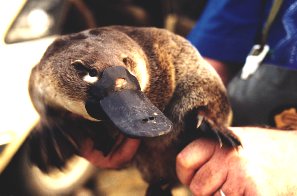
The Duck-Billed Platypus (Orhithorhynchus anatinus)is a very unique animal. In addition to being only one of three extant monotreme species, it is also the only aquatic non-eutherian mammal. Platypi have several unique physiological features, including electrosensation, oviparity, and venom production. This website will only focus on the thermoregulatory and diving capabilities of the platypus. These two topics are the most relevant to the animal physiology course for which this website was created.
Introduction to Monotremata
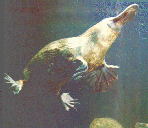 Ornithorhynchus anatinus
| *Don "The Mango King," Yungaburra, Queensland fruit stand proprietor and self-proclaimed platypus expert, disputes this account of platypus phylogeny. He places the platypus in Anatidae, the duck family (personal communication, 11/98). | 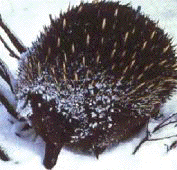 |
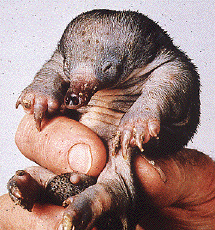 A young Tachyglossus | 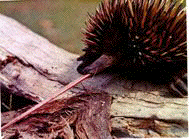
|
- Only one species: Ornithorhynchus anatinus
- Total length around 650 mm, males are larger than females
- Dives in freshwater lakes and streams for food
- Feeds on aquatic invertebrates and vegetation
- Lacks true teeth -- use "gum plates" to grind food
- Closes eyes and ears when diving -- relies on electrosensory perception in bill
- Can eat up to 1/2 body weight per day in captivity
- Only sound is an uncommon, low "growl"
- Nocturnal and crepuscular
- Unlike echidnas, does not develop marsupium
- Occurs only in southern and eastern Australia
- Sources: Bethge, 1997; Anderson and Jones, 1967
Thermal Biology of the Platypus
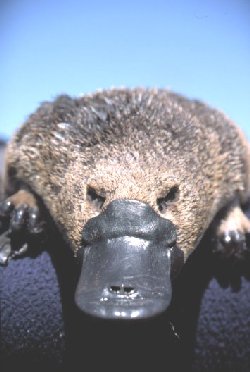 | Body Temperature
Thermoregulation in Water
|
Torpor
Unlike many other small mammals, there is no evidence that the platypus hibernates or undergoes any sort of torpor (Bethge, 1997).
However, platypi are not active at all times. They often spend their longer dives (5-7 min) resting inactively while wedged beneath an object at the bottom of the stream (Evans et al., 1994).
Diving Ability of the Platypus
The platypus obtains its food by foraging
on small invertebrates and plants on stream bottoms (Bethge 1997).
This makes diving a crucial element of its behavior.
Some characteristics of platypus
diving:
- Platypi tend to have two types of dives: short, active, feeding dives
and longer, inactive dives. During inactive dives, the animals usually
rest on the stream bottom by wedging themselves under an object (Evans
et al., 1994).
- Short, active dives average around a minute or less in length, whereas
longer, inactive dives can last up to 11 minutes, although the average
is closer to three minutes (Evans et al., 1994; Jones et al., 1987).
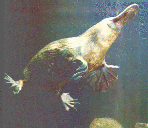
- The ratio of dive:surface time can range from 2:1 to 20:1. Surprisingly,
there is no correlation between time spent diving and time spent at the
surface recovering (Jones et al., 1987). While feeding, platypi will
dive repeatedly over several hours (Bethge, 1997).
- During all dives, heart rate decreases significantly (bradycardia).
This is generally thought to conserve oxygen stored in hemoglobin by decreasing
the rate of blood circulation to the tissues.- In short, active dives, heart rate is decreased but erratic. There
is significant post-dive tachycardia (increase in heart rate), possibly
to compensate for oxygen debt accumulated in the tissues. - In long, inactive dives, heart rate is lower and more stable. There
is no post-dive tachycardia (Evans et al., 1994).
- In short, active dives, heart rate is decreased but erratic. There
Special Aspects of Platypus Diving
What makes platypus diving special?
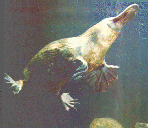 Image courtesy of http://www.healthsci.utas.edu.au/physiol/mono/Mainpage.html | Diving mammals cannot breathe underwater. This presents a problem, as muscular activity and oxidation of glucose require oxygen. Most mammals solve this problem in several ways:
|
A consequence of these strategies is that the muscles build up an oxygen debt in the form of stored lactate. After the dive, the animal must resume full circulation and metabolize the lactate (Schmidt-Neilson, 1997).
Although it is also a diving mammal, the platypus does not share some of these usual traits. We already know that the platypus does not have long surface intervals between dives (dive:surface ratios range from 1:2 to 1:20) but that it does experience bradycardia and tissue hypoperfusion. This suggests that it has found some means of avoiding anaerobic metabolism (Evans et al., 1994).
Let's look at some physiological data:
source: Evans et al., 1994
*A lower pyruvate inhibition ratio indicates more anaerobic respiration.
#A higher number indicates better capacity to buffer lactic acid produced in anaerobiosis.
What do these data tell us?
- Platypus are less dependent on myoglobin for storing oxygen
- Platypus do not have the capacity for extensive anaerobic metabolism
So, how do platypus dive with low myoglobin oxygen stores and without anaerobic respiration?
- Because platypi have lower body temperatures and metabolic rates than eutherian divers, they consume less oxygen while submerged and can subsist with smaller myoglobin oxygen stores (Evans et al., 1994).
- Platypi inhale deeply before diving (Evans et al., 1994), unlike most diving eutherians (Schmidt-Neilson, 1997). Oxygen stores in the lungs may be more important than myoglobin stores.
- While submerged, platypus may utilize high-energy stores that do not require oxidation, such as phosphocreatine (Evans et al., 1994).

